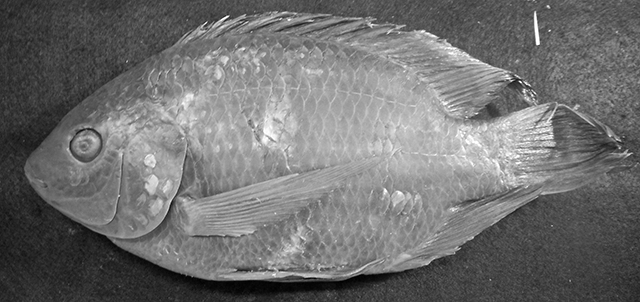| Cichlidae (Cichlids), subfamily: Pseudocrenilabrinae |
| 23.8 cm SL (male/unsexed) |
|
benthopelagic; freshwater; brackish, non-migratory |
| Africa: Lake Mweru and the swamps and saline lakes in Mweru-wa-Ntipa (Ref. 2), the lower (Ref. 2, 95585) and middle (Ref. 95585) Luapula River system and the Lufira River (upper Congo River basin) in Democratic Republic of the Congo and Zambia (Ref. 2). Introduced in Lake Kivu in Rwanda (Ref. 46152). |
|
Dorsal spines (total): 15-17; Dorsal soft rays (total): 11-14; Anal spines: 3-3; Anal soft rays: 9-12; Vertebrae: 30-32. Diagnosis: scales on cheek in 2-3 rows; caudal scales variable, not on the inter-radial membranes except at the base; never stiffening the fin; genital papilla large and tuberculate or scalloped, tasseled in breeding males; generally lighter or darker olive-green; breeding male iridescent dark green to blue-black on head, body and vertical fins; red edge to dorsal and caudal fins (Ref. 2).
Description: body deep with a deep caudal peduncle; snout short; frontal profile rounded; sexual dimorphism well-developed; males possess better developed finnage and their pelvic fins are notable for having very long rays that can reach or overlap the origin of the anal fin (Ref. 52307).
Coloration: body color light to dark gray; body scales with a shiny center in most cases; generally speaking, the entire fish is very light in color; head greenish to bluish; entire head, cheeks and opercles with many black dots or worm-like lines; unpaired fins with red margins; dorsal and caudal fin (and rarely anal fin) with a number of pale dots; ripe and courting males can appear nearly black, but the silvery centers of their body scales remain visible (Ref. 52307). |
| Young Oreochromis mweruensis feed on epiphytic filamentous algae in swampy areas (Ref. 2), but also accept small invertebrates and zooplankton, a tendency they lose with age (Ref. 52307). Adults feed on filamentous algae and detritus (Ref. 52307) and bottom deposits, but those that migrated to the deeper northern end feed almost exclusively on plankton (Ref. 2). |
|
Least Concern (LC); Date assessed: 16 February 2009 Ref. (130435)
|
| harmless |
Source and more info: www.fishbase.org. For personal, classroom, and other internal use only. Not for publication.

